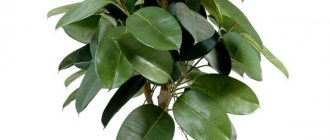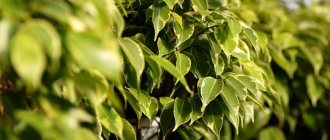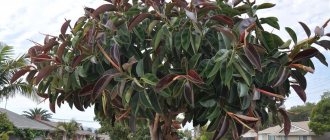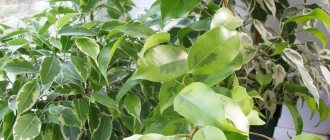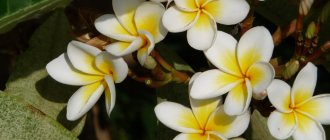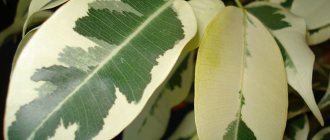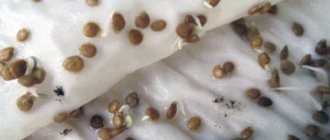Ficus is probably the most popular indoor flower. We became so familiar with its minimalistic beauty that we stopped noticing how beautiful ficus trees are. However, a ficus flower can make any room visually more comfortable - from an apartment to an office.
The value of ficus is not only in aesthetics. It is a natural “air purifier”, absorbing harmful substances that household appliances inevitably produce. This flower is especially good at “fighting” carcinogens that enter the air when frying foods. Ficuses promote sound sleep for the residents of the house, and also protect the “owners” from influenza and ARVI, preventing the growth of bacteria.
We have prepared a selection of the most beautiful ficus trees especially for you. Every novice plant grower will be able to find a flower to their liking.
Aspera
Aspera is an evergreen tree. With good care, Aspera can grow up to 1 meter in height.
The main advantage of this ficus is its leaves. They are quite large, slightly rough to the touch. Their interesting coloring interspersed with white, dark green and light green colors resembles a marble pattern.
Ficus Aspera is quite expensive and quite capricious to care for, but such unsurpassed beauty must certainly require sacrifice.
Ficus Krishna (Bengal)
Typically, Krishna ficus trees are used for office decoration. Not every indoor plant lover has enough space in their apartment to keep a three-meter flower. But if you own a private home, buying a Bengal ficus can be an excellent investment.
In Bangladesh, Sri Lanka and India, the Bengal ficus is considered a symbol of eternity. It is part of a religious cult and is often used to decorate temples. This is a very specific tree that only the most extraordinary owners can appreciate.
Benefits and harms
When contacting the plant, it is advisable to use protective gloves. Ficus sap can cause an allergic reaction.
Attention: Ficus "Lirata" is contraindicated in the home for people suffering from bronchial asthma.
But still, this tree-like plant does more good than harm.
Many medicines and ointments are made from the juice of the lyre-shaped ficus. They are used to treat female diseases. They also treat hemorrhoids, radiculitis, osteochondrosis, and arthritis.
Scientific name
Ficus "Lyrata" has a scientific name - Ficus lyrata. It is increasingly found in homes and is becoming a decoration for offices.
Do you dream of having a cute ficus at home or in the office, but are you lost in all the variety of species? Articles from our experts on growing ficuses Ginseng, Retuza, Amstel King, Carica, Varietis, De Gantelle, Balsamina, Benedicta and Eden will help you make the right choice.
Ficus benjamina
One of the most popular types of this wonderful plant. Ficus benjamina can decorate even a completely simple interior.
If you contact a landscaping specialist, most likely he will immediately offer you to purchase a Benjamin ficus. Unlike most spectacular plants, this ficus does not require special care. He will easily forgive you if you completely forgot to water it during the deadline, and this will not affect the appearance of the plant in any way. The only requirement for those who are going to purchase this miracle is to provide the ficus with a sufficient amount of sunlight.
Diseases and pests
Care errors, primarily stagnation of water and excessively humid air, combined with low temperatures, lead to weakening of the plant and its damage by fungal infections.
In this case, you need to optimize watering, spraying, temperature and treat the ficus with fungicides.
Ficus can be attacked by mealybugs, spider mites and scale insects.
Prevention against such “guests” is regular washing of the leaves, but if insects appear, the first measure is to remove the pests using a cotton swab dipped in alcohol or treatment with a soap solution.
Advice : The most effective remedy for pests is systemic insecticides.
“Binnendiya Ali” (willow leaf)
This ficus received its name in honor of the man who first discovered this amazing plant - Simon Benedict. This ficus is quite popular and has already managed to win the hearts of thousands of Russian plant growers. Ficus Benedict, as it is also called, is quite unpretentious in care - and therefore especially loved by those who are not used to spending too much time caring for indoor flowers.
Binnendiya Ali is quite different from other varieties of ficus. What makes it especially beautiful are the unusually shaped leaves - narrow and pointed at the tips. The color of the ficus can be either monochromatic or variegated, depending on the variety.
Rare varieties
The modern choice of the described plant is also represented by other crops, among which there are quite rare varieties of ficus. Their low prevalence is mainly due to the complexity of care. At the same time, the decorative qualities of rare representatives of the genus Ficus are very high. Let us present two of the most interesting specimens belonging to this category.
Ficus Krishna (Ficus krishnae) is distinguished by amazing leaves, the shape of which resembles a bell.
With such a voluminous “vessel” you can easily scoop up water and quench your thirst. By the way, according to legend, this is exactly what Krishna did, after whom such an unusual culture was named. This ficus is a real Indian exotic. Another highlight is the delicate silvery bark on young branches.
Rare ficuses include the reed ficus (Ficus Iingua), the name of which is explained by the unusual shape of the leaves.
A thin bright brown trunk of a ficus and branches of the same color peek out from under the smooth leaf plates. By choosing a pot of the appropriate color for it, you can make a unique composition. This small-leaved ficus requires diffused light, abundant watering and regular fertilization.
Indoor plants that will surprise you with their diversity: peperomia, sansevieria, tradescantia.
Palmera (bottle)
Flower growers adore Palmer's ficuses because of the unusual shape of the trunk, reminiscent of a bottle - the wide base becomes thinner towards the top. Wise nature awarded the ficus with such a design that it could retain moisture and adapt to an arid climate.
The leaves of the bottle ficus are also unusually beautiful - large, heart-shaped. The color of the leaf blade is rich, bright green.
This plant is completely unpretentious in care, so it is suitable even for very forgetful housewives. The main condition for keeping a bottle ficus is to place the pot in a sunny place.
Reproduction methods Belize Elastic
Ficus is recommended to be propagated in the spring, during the active growth phase. Two popular methods are cuttings and air layering.
Air layering
- At the end of winter, an incision is made on the woody part of the branch.
- The area is covered with sphagnum moss and wrapped in polyethylene.
- The moss is watered to keep it constantly moist.
- Roots appear in 2-3 weeks.
- The branch is cut off and, together with the moss, transplanted into the ground.
Reference! Instead of moss, you can use sand; it is important to wet it in a timely manner.
Cherry-shaped (“Cape”)
The cherry ficus is native to the tropical forests of East India, Malaysia and the island of Java. This is a small but very beautiful tree, which in natural conditions can grow up to 10 meters in height.
The leaves of the Cape ficus are dark green in color, long, narrowed at the base and closer to the top. They are rough to the touch due to the bristly hairs on the leaf blade.
This is one of the most unpretentious varieties of ficus. The plant can even withstand the absence of sunlight, which usually has a detrimental effect on flowers.
What kinds of plants have large leaves?
Rubber-bearing (elastic)
Elastica has large leaves, dark green, some with light spots. The leaf grows straight from the trunk. With proper care indoors it grows up to 2 m tall, and in nature up to 30 m. The plant can secrete milky sap.
Important! If milky juice gets on human skin, irritation may occur!
Lyre-shaped
In nature, the plant grows as an independent tree, reaching a height of 15 m. It received its name because of the similarity of the leaf to a lyre. Indoors it grows up to 3 m tall. The leaves are large, wavy with distinct veins. The bark is rough, brown with a tint of gray.
Bengali or Ali
This species is native to India. In nature it grows to enormous sizes, has aerial roots that fall to the ground, take root and grow into full-fledged trunks. The leaves are dense, oval, green with light veins. Indoors it grows up to 3 m, and in nature up to 40 m.
Binnendijka
An evergreen crop in the form of a tree or shrub. The leaves are oblong, smooth, glossy, less than 30 cm long and up to 4 cm wide, uniformly dark green in color or light gray with white strokes. In nature it reaches a height of 20 m, and in rooms no more than 2 m. The bark is dark with light streaks.
Deltoid (variegated)
It owes its name to the unusual shape of the leaves, similar to the Greek letter “delta”. The leaves, which resemble a triangle with rounded corners, make this plant especially beautiful. The color of the leaf blade is grassy green, with barely noticeable white dots.
The deltoid ficus bears fruit even indoors, however, its spherical fruits are completely inedible and do not have any aesthetic value. Plant care is standard. Variegated ficus requires bright sunlight, no drafts, and moderate watering.
Description of the species
Ficus Baroque in the photo looks like an interesting design structure. Usually this flower does not have the same type of leaves, each tree will have a feature that manifests itself through the shape of the leaf. It will always be twisted, but in completely different ways. One leaf can grow in such a way that it twists all the others around itself, resulting in a double crown that will give the plant uniqueness. The leaves grow small in length, maximum 4 cm, and in width - 2.
Each leaf is dense in structure, smooth and shiny. The leaf has a petiole that shines brightly when the sun's rays hit it. The leaf color is light green. When a flower begins to grow quickly, its branches with leaves can rise rapidly. If you do plant a single plant, its trunk and shoots will be thin, in which case you will need to place the flower where it will feel safe and its leaves will not break off.
The main thing is to observe the temperature regime when growing a flower, so that the temperature does not jump up and down. If this condition is violated, the Ficus Barok may protest and shed all its leaves, this can happen in a few days. This phenomenon often occurs in the Benjamin family, so you must strictly follow the rules for caring for the Baroque ficus. The main rules are temperature and humidity.
Ficus Baroque is propagated by cuttings. You can find seeds, but many experts say that the survival rate of the fetus is almost zero. It is best to use cuttings and plant not one, but several plants in one pot. If you are interested in Ficus Baroque, photos can convey all the peculiarity and beauty of the flower.
Montana (oakleaf)
This ficus is native to the tropical forests of Indonesia, Malaysia and Indochina. It can settle in completely atypical areas - in the mountains, on river banks, and even be a weed in tea plantations. Ficus Montana is sometimes called “mountain”.
The leaves of the plant are similar to oak leaves. They are rough to the touch due to fine bristly hairs.
Caring for the oakleaf ficus is quite simple; the main thing is to choose a warm, well-lit place for the flower and provide abundant watering.
Figs (“carika”)
Yes, yes, the tree with juicy sweet fruits known to us all is one of the varieties of ficus. This amazing plant can bear fruit even indoors!
In its natural environment, Ficus Carica produces crops on average twice a year. The tree is pollinated by small wasps, whose bites are very painful for humans.
To maintain a tree at home, you need a bright, but at the same time cool room. To pollinate a flower under artificial conditions, you need to collect pollen from another tree.
Pumila (dwarf)
A very beautiful and unusual evergreen indoor plant. Pumila leaves can vary significantly in shape and color, depending on the variety. But, as a rule, the leaves of the dwarf ficus are very tiny, which is why it got its name. The stem of the plant is thin, flexible, and grows incredibly quickly.
This species is not low maintenance. It needs sunlight, warmth and abundant watering - otherwise the plant may die.
General rules of care and reproduction
Ficus domestica is unpretentious, so it is not demanding in care. However, any gardener needs to become familiar with the general growing features that apply to most plant species.
Temperature
Ficuses are very afraid of drafts. With sudden changes in temperature and in a draft, they can unexpectedly shed some of their foliage.
In addition, they are very sensitive to air that is dry as a result of heating appliances. To reduce the harmful effects of heaters, the leaves should be sprayed with water more often. For these indoor flowers, room temperature is ideal: in summer no more than 30°C, and in the cold season - about 20°C.
Watering
The houseplant does not tolerate constant dryness, but it is also not a good idea to always keep it in wet soil. Ideally, it should be watered after the top layer of soil has dried, which is determined using a stick that needs to be inserted a couple of centimeters into the soil. If it turns out to be dry, it means that it is time to water the crop.
In addition, the plant needs to be sprayed 2 times a week. It should be borne in mind that some species, for example, indoor ficus lyre-shaped, do not tolerate such moisture, so it is better to wipe their leaves with a gentle damp cloth.
The exception is dwarf ficus: they are very moisture-loving and need their soil to always be moist.
Lighting
When growing ficuses, you should remember that the most suitable lighting for them is medium-intensity lighting, penetrating through eastern or western windows. These plants react poorly to both direct sunlight and dense shade. In winter, artificial lighting is welcome.
Top dressing
The ideal period for feeding ficus is from April to July inclusive, when the flower grows intensively. Mineral and organic mixtures should be applied at intervals of three weeks. Their composition depends on the variety, age and condition of the plant.
In winter, ficus plants should not be fed. Although in warm rooms their growth continues at this time.
Trimming
This procedure is necessary to form the crown and remove excess branches. In spring and autumn, standard pruning of the top, among other things, helps stimulate the growth of side shoots. A large plant may need sanitary pruning, which will rid the ficus of dried and damaged branches and leaves.
Keep shoots from growing upward. Pinch the main shoot at the height where you plan to form the first tier of the crown, the second vertical one at the height of the second tier, etc. This way you will get a brightly decorative tree.
The rejuvenating procedure is the most merciless. As a result of such pruning, only 3-4 cm of stems remain above the soil. The crop may need rejuvenation to recover after freezing. For pinching there are no restrictions either on the time of year or on the age of the exotic. This procedure involves removing excess shoots.
Elastica (rubber)
Perhaps the most famous variety of ficus. Even if you are not at all interested in indoor plants, you have probably seen the rubber-bearing ficus somewhere - it is incredibly common, and is a huge success among those who want to green up their apartment.
There is a belief that this particular type of ficus brings family happiness. Whether you believe in omens or not is up to you to decide - but the beauty of this ficus lies not only in its mystical meaning.
Rubber-bearing ficus has many varieties. As a rule, they are bred artificially to make the plant more compact.
Anomani (crater-leaved)
It is often called forest ficus. In nature, this plant can be found in the forests of South Africa, Uganda, Zambia and Angola.
The leaves of the ficus Anomani are very unusual - cup-shaped, with a pointed tip. The shade of the leaf blade is bright, rich green. The surface of the leaves is smooth, leathery, with a characteristic glossy sheen.
The crater-leaved ficus is quite unpretentious in care and is perhaps the best choice for a novice plant grower.
Lyre-shaped
In the African tropics, the lyre-shaped ficus is a fairly large evergreen tree. However, in indoor culture the plant will not be able to grow to 15 meters due to lack of sunlight. However, this is even for the best - otherwise he would not have been able to fit even in the most spacious apartment.
The main advantage of the lyre-shaped ficus is, of course, its leaves. The unusual shape of the leaf resembles a famous musical instrument. It is thanks to this non-standard decoration that the lyre-shaped ficus has become a favorite home plant for millions of people.
Microcarpa
This is a very tiny tree, externally resembling a smaller copy of its larger relatives. Unlike most dwarf trees, ficus microcarpa can bear fruit, although in indoor conditions this phenomenon is extremely rare.
Microcarpa is an unusually beautiful type of ficus. Its charm lies both in the unusual structure of the roots, which can take on bizarre shapes, and in the lush green crown.
This tree does not tolerate drafts and cold. In the event of a sharp change in temperature, all the leaves fall off - this phenomenon should not be alarmed.
How to form a bonsai from a ficus
If you want to grow a bonsai from a ficus, then you need to:
- Choose your favorite variety. The following ficuses are suitable for this: Bengal, Benjamin, Microcarpa, Carica, Dark-leaved, Rust-red. What a ficus bonsai looks like, photo.
Bonsai from different varieties of ficus - Decide on the form. As a rule, when growing bonsai, one of the following forms is used: erect, irregularly erect, inclined, forked, broom-shaped, grove.
Beautiful forms for bonsai - Formation of roots and crown. Roots and shoots are pruned until the required volume of the trunk is reached. Once the tree reaches the desired size, you can begin to form the crown and trunk.
Diagram of root formation.
Method of pruning the root system
Petiolaris
One of the most beautiful varieties of ficus. It is distinguished by a fairly thick trunk and burgundy-red veins on the leaves. In winter, the leaves turn pale and the veins take on a soft pink hue.
This is a very rare species that is not easy to find on sale. You can admire the beauty of Petiolaris in the botanical gardens. However, if you get a chance to get such beauty home, do not refuse - like most ficuses, Petiolaris is quite unpretentious in care.
Auriculate
An exotic plant native to India and Southeast Asia. It has incredibly large leaves that resemble elephant ears. Thanks to their unusual structure, this ficus got its name. Interestingly, the young leaves of the auricular ficus have a reddish tint - and begin to turn green only with time.
Due to its very impressive size, this variety of ficus is not very suitable for breeding at home. But they can perfectly decorate an office, a hall or a personal plot.
Types of ficus with photos and names
Beginning flower growers, wanting to acquire an interesting plant, usually get lost when studying the types of ficus. The fact is that even the most common of them are represented by a huge number of varieties. These are evergreen and deciduous, the most common and simply unique plants: curly, spotted, with white leaves, original flowering, fruit-bearing, and so on.
By the way, the well-known fig is also a representative of the Ficus family. A deciduous plant that sheds its green cover in October.
This material presents a wide variety of decorative indoor ficus plants. Thanks to this, everyone will be able to find information on many varieties: their appearance, characteristics, features of caring for these indoor flowers, and even photographs showing rare varieties. It is impossible to observe how ficus blooms at home. This phenomenon is rare in natural conditions.
So, the plant belongs to the mulberry family. All types of ficus are represented by the following varieties:
- rubber;
- tree-like;
- ampelous.
Rubber-bearing
Plants of the genus Ficus elastica, as their name suggests, are distinguished by highly flexible stems. A large number of varieties of this species have been developed. It attracts with its glossy large hard leaves of various colors.
Previously, rubber-bearing ficus trees were cultivated on a large scale for the purpose of industrial production of rubber.
These are light-loving flowers that can, if necessary, adapt to darker places. If you grow this bush ficus in a spacious room, then over time its crown may reach the ceiling. This is possible even if the room height is 10 m!
The most common types of elastic are:
Robusta (Ficus Robusta) - with fleshy green oval leaves that have an unusual ribbed surface (pictured above).
Abidjan (Ficus Abidjan) is a tall indoor plant with a massive stem. It is distinguished by rather large dark green leaves with a light central vein. The bottom of the plates may have a red tint.
Variety Abidjan Variety Melanie Variety Belize
Melanie, or laurel (Ficus Melany) is a low-growing variety with thick, pointed leaves, the silhouette of which is emphasized by a white edge.
Belize (Ficus Belize) is a plant with unusually high decorative properties, provided by large spotted leaves, painted in three colors that smoothly fade into each other: green, cream and pink.
Tree-like
These are beautiful and stately indoor flowers. They come with both large luxurious and small, but multiple leaves on a branched crown. It is the tree-like ficus macrophylla that is often used by florists as a tapeworm when creating the interior of a room. Also, these plants combine well with other types of indoor flowers, forming a green island, and some specimens are grown as bonsai trees.
One of the most striking representatives of this plant found in the wild is the Ficus Altissima, which reaches a height of 30 meters.
The tree-like variety of indoor ficuses includes a considerable list of varieties.
Microcarpa (Ficus microcarpa) will decorate the room not only with a short trunk crowned with a dense crown, but also with a very decorative appearance of a real “bouquet” of aerial roots. All components of a strong, thick-leaved plant form an hourglass silhouette.
Triangularis (Ficus Whait Margin) is a very unusual crop with white-green leaves, characterized by a significant growth rate. This variegated plant, despite its unique appearance, is one of the most unpretentious. The very interesting shape of the leaves is close to triangular, which gave the variety its name.
Under favorable conditions, Triangularis can bloom with spherical inflorescences resembling brown moss. Later, bright cream or burgundy berries the size of cherries ripen on the plant.
"Eldorado" (Ficus eldorado) is also a variegated ficus, but its color is a chaotic white-beige speck. Some areas of the sheet may be plain.
“Safari” (Ficus safari) is the closest relative of “Eldorado”, but its specks do not have clear boundaries, they seem to be shaded.
“Naomi Gold” (Ficus Naomi Cold) is an even more “blurred” version of the previous two varieties.
All three plants belong to the broad species Ficus benjamina, perhaps the most popular. This also includes the Lakia variety, the leaves of which have a dark green center and white-beige edges.
"Natasha" (Ficus Natasja) is a slow-growing representative of the species, which, according to signs, brings mutual understanding to the family. At first it is a bush, and over time, when it gains height, its trunk becomes bare, and the plant turns into a beautiful meter-long tree.
Blunt (Ficus retusa) is a plant characterized by a characteristic grayish-yellow coloring of the bark, with small thick oval pointed leaves.
The lyre-shaped ficus (Ficus lurata) is a tree with very large leaves, which in their shape resemble a corresponding musical instrument. The length of one leaf blade can reach 50 cm. The rich green color of the foliage is bordered by a light wavy line.
"Ali" (Ficus binnendijkii) - this crop can be called the "irregular ficus" because of its long and narrow leaves. Many people, seeing the plant for the first time, mistakenly consider it a palm tree. However, it is a common representative of its extensive family, but more holly.
It can also be easily confused with the rarer varieties of ficus - Ficus formosana and Ficus neriifolia. But the latter, if you look closely, has wider, lighter leaves, while the Ali variety (pictured on the left) is narrow and drooping, like a willow.
Ampelous
When describing this type of ficus, you should first of all pay attention to their “creeping” properties, which makes them an excellent interior decoration. The size of ampelous ficuses is much smaller than that of the tree species.
The following varieties are the most popular in this group.
Mountain ficus (Ficus montana) is a long vine with large leaves that are shaped like oak leaves. The shoots of this climbing plant are easily distinguished by the presence of strong pubescence.
Ficus pumila is a small bush with small leaves. However, the grown plant looks quite impressive - like a solid green canvas that covers the wall. In addition, with small leaves - barely reaching 3 cm - and thin roots, it has acquired the ability to “climb” on any kind of surface. Thanks to this, you can create a complex design composition.
Creeping ficus or rooting ficus (Ficus radicans) is another striking representative of its species. This is a vine with fairly large green leaves (up to 5 cm), capable of clinging to any surface with the help of powerful sucker roots.
Ficus repens can be grown as a hanging plant. An interesting design option would be to use a support or a small curly driftwood along which the branches will quickly spread.
